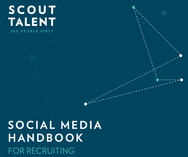This post is written by our Senior Recruitment Marketing Specialist, Shane Keane. It is based on our free guide on the same topic and you can find that here.
With the omnipresence of social media and the increasing costs associated with advertising on traditional job boards such as LinkedIn, Monster, and Indeed, more and more recruiters are making the move to social media. HR teams and hiring managers are taking advantage of free native advertising to connect with their talent pool and keep them informed of open opportunities.
Your target audience
Of course, it’s worth asking what is the target audience when it comes to social media. Which roles are going to appeal most to that audience? Currently, 1 in 2 people are engaging with social networking sites at least once a day, and within the 18-29 age group, it’s 3 in 4.
From the 2016 Sensis Social Media Report, we know that the average number of times people check Facebook is 32 times a week. Across that week this equates to approximately 12.5 hours. That’s half a day each week that someone has dedicated to scrolling through their newsfeed which is a huge window within which to position your organization, your brand, and your available opportunities.
It’s not just the audience and potential engagement that makes social media worthwhile to HR teams. Social media can get a message out quickly thanks to your followers and other users doing the leg work for you. Through comments, tagging, and sharing links you can increase your return on investment all thanks to the people you’re targeting without actually needing to invest excessively in your advertisement strategy.
Another benefit of using social media as part of your recruitment strategy is being able to showcase your brand, and by extension your employer brand. Social media gives you a much bigger canvas to showcase who it is that you are as an organization and what makes you worthwhile as an employer of choice. Compare this to ads on websites like Indeed, where all jobs listed in search results look pretty similar. There are no images or obvious branding other than maybe a logo. Which doesn’t exactly give you a great chance to win people over.
However, compare that to social media where your enticing branding has so much more space to breathe. Furthermore, a 2019 study conducted by Scout Talent revealed that more than half of job seekers applied for a role they had seen advertised on social media.
Using social media for segmentation
If you’re an organization with a diverse array of roles you’re looking to fill, most social media sites will actually give you much more segmenting capabilities than their job board counterparts.
Typically social media sites have great targeting capabilities allowing you to target audiences across all industries easily. That said, individuals that fall into the advertising, marketing, entry, graduate, sales, hospitality, or retail categories are typically easier to target using social media. Individuals within these groups are often more engaged with social media making them easier to target and appeal to.
In terms of demographics, you’ll likely find the best results when trying to attract millennials as they make up the highest percentage of users. But this definitely doesn’t mean you should disregard using social media to recruit talent outside of the millennial age group. 52% of individuals aged 40 to 49 will check social media at least once a day as will 38% of 50-64 year-olds.
It’s absolutely true that you can attract all generations via social media, but it’s likely no surprise to hear that certain platforms are preferred by individuals belonging to different generations. As examples, the 18 to 29 age group is typically found easiest on Instagram. For individuals over 30, LinkedIn is the best source. If in doubt about where you should be targeting Facebook is the way to go as it’s widely-used across all ages.
Advertising on social media
Given the huge potential for targeting candidates as part of your recruitment campaign through social media, it’s important to make sure you get it right.
If you’re advertising for an accountant position in Toronto you don’t want to pay to have teachers in Montreal see your job ad. Targeting capabilities do differ slightly across the various social platforms but most allow you to narrow your exposure by applying filters such as location, gender, age, language, and educational status.
Within LinkedIn you’re even able to target by company name, industry, and size, job title, seniority, schools, and skills. There’s huge potential here but you should be cautious if you are targeting based on gender, age, and language as you’ll likely be opening yourself up to accusations of discrimination.
Our recommendation is to target candidates using parameters such as Job Titles, Employers, Interests, Recent Activity, and Years of Experience. Targeting also allows you to exclude potential candidates as well which can be useful if you want to avoid people who have worked for certain organizations or, if you’re a larger organization, avoid targeting people who already work for you.
Paid VS Organic posts
In general, advertising on social media typically takes two forms – paid and organic advertising.
Organic advertising is when a company posts an update on their social media page with no money behind it. People who follow that company’s page may see the post in their news feed while scrolling through and if they engage with it, their connections may see it too. But it is possible that people who follow you may not see it and while this type of advertising is free if your company does not have a large following on Facebook or a strong employer brand the chances of people engaging with the post are relatively low.
A paid or sponsored social media posting doesn’t just appear in the news feed of your followers but is promoted and can appear in a number of different locations based on your specifications. This means people who are not following your page can still potentially see your advert in their news feed. As people engage with your advertisement this further increases the reach of your posting.
Paid advertising typically generates better results than organic ads especially as the competition for ad space heats up. Whether you use free or paid advertising really depends on who you are and your needs. But if you have the budget for it, investing in paid advertising on social media can be an affordable way of improving your recruitment strategy.
The messaging
Paying for an advert doesn’t guarantee success on its own. With so much content being delivered directly to people’s newsfeeds attention spans have become shorter. In order to win someone’s interest, your message needs to be visual and either be concise or grab attention pretty rapidly.
Videos are the best way to catch a candidate’s eyes and drive engagement, according to a 2015 study by Animoto, four times as many consumers would rather watch a video about a product than read about it. If you don’t have a career video you can try using effective imagery that makes your ad stand out and be remembered.
According to human brain development expert, John Medina, if the text is paired with a relevant image people remember 55% more of the information three days later than without an image. If images aren’t an option and your advertisement is going to be to more text than video make sure you nail your copy. In a recent webinar of ours, I brought up a job description from Indeed and noted how a qualification required excellent communication skills in English but the word communication was spelt wrong. These sorts of mistakes and typos will obliterate the effectiveness of your advertisement. Beyond dotting “I’s” and crossing “T’s” correctly have a clear vision when you’re crafting your message. Use keywords that will stand out to relevant jobseekers while keeping things concise and using a “Call to action” button or link to allow intrigued job seekers to learn more.
How much should I spend?
In terms of spending, we here at Scout Talent recommend $200 for campaigns spanning roughly 2 to 4 weeks in length. Competition for advertising placements on sites like Facebook is based on which advert matches Facebook users’ interests rather than the highest bidder. As such we’ve found that adding another $100 or more to the budget doesn’t make much of a difference for most small to mid-sized organizations.
Once more I’d like to thank the recruitment specialists of Scout Talent for putting together a lot of the information in this podcast. If you’re interested in using social media as part of your recruitment process but don’t know where to get started or if you just don’t have the content you need to share please do reach out to talk with one of our specialists.
We’ve recently completed a number of career videos that our clients are now actively using for their recruitment campaigns and we’d love to help you build yours.
If you’d like to see how Scout Talent can support you, please feel free to reach out to us via email at hello@scouttalent.ca or by phone at 1 866 474 3140.
If you would like to download our Social Media Handbook, please enter your details below:
We care about your privacy, no spam and unsubscribe at any time.






